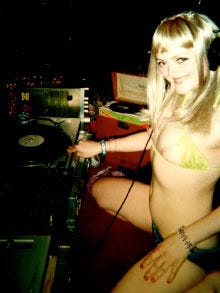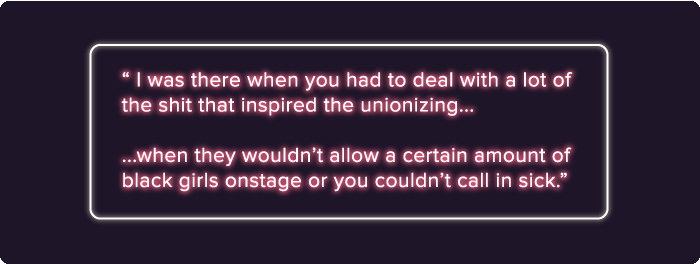
By Michelle Tea
The high cost of living in San Francisco has claimed another casualty: the iconic Lusty Lady, the North Beach strip club that boasted being the last old-school-style peep show in the country as well as the first such place to unionize and eventually become a worker-owned co-op. It’s slated to close September 2. In losing the Lusty, the city loses a lot — a legendary haven of feminist sex-positivity, an idealistic business model for an industry rife with exploitation, and a place where a sexually adventurous, broke female could make a creative paycheck, gaining a few lifelong friends in the process.
From its beginning in 1976, the Lusty has always been different from the other clubs that dot the North Beach landscape. Says Carol Queen, the sexologist who founded and directs the Center for Sex and Culture (and a former Lusty Lady), “The history of the Lusty is that it was founded by some Seattle sexual-freedom activists. Their original Seattle place included male performers, not just women, so it was very different than your average exotic-dance place. By the time it got settled in North Beach, that part of the business plan had been abandoned.”
When Queen joined the Lusty Lady in 1990, the peep show had already begun to drift from its original, utopic vision and was embroiled in a “battle between the punks and dykes and people who thought it was a cool job, and the management, who wanted girl-next-door types. I would say there was a cultural discord among workers and management. And, of course, in any business, there is that; it’s not unique to the Lusty Lady or exotic emporia. It was the kind of discord you’d expect from radical San Francisco, only naked.”
Gina Gold, a writer and performer who runs the East Bay storytelling event The Gina Gold Show, worked at the Lusty during this discordant era, from 1989 to 1994. “I was there when you had to deal with a lot of the shit that inspired the unionizing, when they wouldn’t allow a certain amount of black girls onstage or you couldn’t call in sick. One manager told me I had to lose 10 pounds and sign a piece of paper agreeing to that. She was concerned that I would lose the weight in my breasts — as if I could control that.” But even as the club permitted the discrimination that plagued the industry, there was much that set it apart.
“The management was run in the style of Landmark Forum — literally,” Gold recalls. “If you were late, you had to come in and remake your agreement to be on time. It was really bizarre. Here I am, this girl from Queens at a women-centered, Landmark Forum–based strip club. You can’t get more California than that.”



Management during Gold’s tenure instituted a short-lived holistic-health-insurance plan, and one manager coached the 19-year-old dancer on how to protect herself. “There was a guy who was following me to work from the BART station, and I’d asked management to please schedule me during the day, because this man followed me every night. She was like, ‘Well, what do you do when that happens?’, and I was like, ‘I don’t do anything.’ She said, ‘You need to turn around and tell him to stop. Practice on the customers.’ A customer would yell through the glass, ‘Let me see your ass,’ and I would say back, ‘You do not direct the show; you do not tell me what to do.’ I would be calm, and being calm like that gave me so much power. For every fucked-up thing I can say about the Lusty, there was some powerful, witchy shit that was happening there. I was letting any old jackass follow me, and being able to practice saying no where it was safe, behind glass, with no one making me feel stupid about it — that seriously changed my life.”
The possibilities for feminism and empowerment only increased as the workers experimented with different business models, creating for more recent employees “a cultural place that draws people in for many reasons, not just a paycheck,” according to Queen.
“I think of the Lusty Lady in a lot of ways as kind of like a sorority,” says Tennessee, who worked at the Lusty for four years beginning in 2006. “It felt like a sorority of hardworking, largely working-class women with amazing senses of humor. I don’t know if there’s something about being naked in a fish tank for hours or the kinds of women who work there, but I have never made so many friends at a workplace before.”
“I didn’t go to college,” says Simone de la Ghetto, who danced at the Lusty for 13 years from 1991 to 2004. “The Lusty Lady was my college. It changed the way I see the world, and it changed the way I see people. If I hadn’t had the experience of working there, I’d probably be some corporate yahoo. I wouldn’t have this creative edge, this little grit to me that I love. And I wouldn’t have met the amazingly talented folks who worked there.”
The college metaphor is a popular one among ex-employees, including punk artist Brontez Purnell, who had a staff job at the Lusty in 2006. “I mopped jizz,” he says, recounting his duties. “I was a receptionist. I greeted people, and I escorted girls from the Private Pleasures booth so they didn’t get harassed. Every time I hear that someone worked at the Lusty, I feel like we went to college together. It’s a weird little alma mater for Bay Area punks and sex workers.”
The co-op business model, in which shared profits encouraged all the women to root for their coworkers to earn cash, did much to kill the competition that can squash female friendship in other clubs. Says Tennessee, “In the Private Pleasures booth, you kept 56 percent of what you made, and then 45 percent goes into the club’s revenue pool, and everyone got a cut of that money. In other clubs, the more money you make, the less money other dancers make. They set you up to be invested in each other not doing well. We were always supporting each other and always wanting each other to make more money.”

Other dancers agree. Corrie Vargas, a California Institute of Integral Studies grad student who danced at the Lusty from 2007 to 2010, says, “The fact that we weren’t competing for wages meant that we could bond in ways I never found possible in other clubs. To this day, my best friends are all ex-Lusties, though at this point we’re called ‘Crusties.’ A Crusty is a Lusty that’s been around a long time.”
Both the club’s progressive business model and the rise of Internet porn made it impossible for the Lusty Lady to make the money it needs to stay in business and compete with its more mainstream neighbors, such as the Hustler Club, which plans to occupy the space the Lusty is being evicted from. Says Sweetcheeks, a dancer who worked at the Lusty from 2007 to 2009, “I love the concept of the co-operative business model, and it is so beautifully matched to the Lusty Lady’s values, but from an administrative and business-development perspective, this business was not equipped to adapt swiftly and for the big picture.”
Chelsea Starr, a DJ who currently strips at clubs in Portland, Oregon, worked at the Lusty during their shift to co-op and agrees that the model was tough on a strip club. “When I worked there, it wasn’t because I was a women’s-studies major wanting experience. I wanted to earn money. Once it became worker-owned — I’m going to be so unpopular for saying this, but the quality of the shows went down. When the experiment failed, it felt like a sinking ship I wanted to jump off. It felt like we were providing the men of North Beach with a free service. I was making 20 dollars an hour when I started, and it steadily dropped until I was like, I’m not getting naked for 12 dollars an hour.”
When the Lusty closes its doors, workers may come to feel like the carriers of a precious history — a strip bar that celebrated its co-op birthday each year with a giant ‘Play Day’ party where dancers could get it on with each other and DJ in the nude. This was a place with a free box that provided free stripper gear from outgoing dancers, and for which bake sales were held in Dolores Park to pay for the club’s float in the Pride Parade.
Says writer Rhiannon Argo, who fictionalized her four years at the Lusty in the mid-’00s in her novel, The Creamsickle, “I was always inspired working there. It was like a slumber party with girls telling their secrets. There was also the ‘Booth Book.’ People would write down their love drama and their life drama, and when you worked a shift in Private Pleasures, you could read up on everything. Sometimes people would ask for advice. Whoever has that book is sitting on a gold mine.”
Carol Queen thinks the archive at the Center for Sex and Culture would be a perfect home for the Booth Books. “We would really love them, and honor and cherish them,” she says. “It’s our responsibility to not let these things scatter to the winds. In 100 years, people are going to be looking at this stuff, saying, ‘Whoa! Whoa! Whoa!’”
Design by Ryan Raphael.







